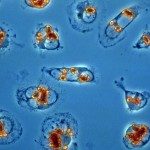Link to Pubmed [PMID] – 37127215
Link to DOI – 10.1016/j.actatropica.2023.106935
Acta Trop 2023 Jul; 243(): 106935
Leishmania tarentolae is a non-pathogenic species first isolated from geckoes in the Mediterranean basin. The finding that dogs test positive against both Leishmania infantum and L. tarentolae raises questions regarding the ability of the latter species to persist and adapt to new hosts. This study aimed to evaluate in vitro the capability of L. tarentolae to colonize, survive and persist in canine primary monocyte-derived mononuclear cells. Monocytes were isolated from dog whole blood samples and placed in 24-well plates for differentiation into macrophages and for incubation with L. tarentolae field-isolated strains (RI-325 and SF-178) and laboratory (LEM-124) strain; the parasite burden was assessed at different time points post-infection. The L. infantum laboratory strain (MON-1) was used as control. Infection parameters were evaluated by microscopy, counting the number of amastigotes/200 infected cells, and by duplex real-time PCR from supernatants and detached cells. Similar to L. infantum, L. tarentolae strains developed into round-shaped amastigote-like forms, with higher infection rates detected at 4 h followed by an overall decrease until 48 h. RI-325 presented also a higher infection rate at 72 h. Data showed that L. tarentolae strains infect and persist inside in vitro primary canine mononuclear cells, opening new perspectives for further laboratory studies.
